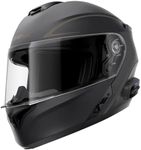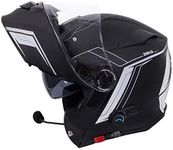Buying Guide for the Best Bluetooth Motorcycle Helmets
Choosing the right Bluetooth motorcycle helmet is crucial for ensuring safety, comfort, and connectivity while riding. A Bluetooth helmet allows you to communicate with fellow riders, listen to music, and receive GPS directions without taking your hands off the handlebars. When selecting a helmet, consider the fit, safety certifications, and the quality of the Bluetooth system. It's important to find a helmet that not only fits your head comfortably but also meets your communication needs on the road.Bluetooth VersionThe Bluetooth version in a helmet determines the quality and reliability of the wireless connection. Newer versions, like Bluetooth 4.0 and above, offer better range, faster data transfer, and improved battery efficiency. If you plan to use your helmet for long rides or in areas with potential interference, opt for a helmet with a newer Bluetooth version to ensure a stable connection. For basic communication and music streaming, older versions might suffice, but for the best experience, aim for the latest version available.
Battery LifeBattery life is a critical factor as it dictates how long you can use the Bluetooth features without needing a recharge. Helmets with longer battery life are ideal for long-distance riders who spend hours on the road. Typically, battery life can range from a few hours to over 20 hours of talk time. Consider your riding habits; if you often take long trips, look for a helmet with extended battery life. For shorter commutes, a helmet with moderate battery life may be sufficient.
Intercom RangeIntercom range refers to the distance over which you can communicate with other riders using the helmet's Bluetooth system. This is particularly important for group rides. Ranges can vary from a few hundred meters to several kilometers. If you frequently ride in groups or in open areas, a helmet with a longer intercom range will be beneficial. For city riding or solo trips, a shorter range might be adequate.
Sound QualitySound quality affects how well you can hear music, GPS directions, and conversations. High-quality speakers and noise-canceling microphones enhance the audio experience, especially at high speeds. If you value clear sound and often ride in noisy environments, prioritize helmets with superior sound systems. For casual riders who use Bluetooth features sparingly, standard sound quality may be acceptable.
Fit and ComfortThe fit and comfort of a helmet are paramount for safety and enjoyment. A well-fitting helmet should be snug but not too tight, with even pressure around your head. Comfort features like padding, ventilation, and weight also play a role in how pleasant the helmet is to wear for extended periods. Try on different sizes and styles to find the best fit for your head shape and riding style. A comfortable helmet will encourage you to wear it consistently, enhancing your safety on the road.
Safety CertificationsSafety certifications indicate that a helmet meets specific safety standards. Look for certifications like DOT, ECE, or Snell, which ensure the helmet has passed rigorous testing. These certifications are crucial for protecting your head in the event of an accident. Always choose a helmet with recognized safety certifications to ensure maximum protection while riding.












